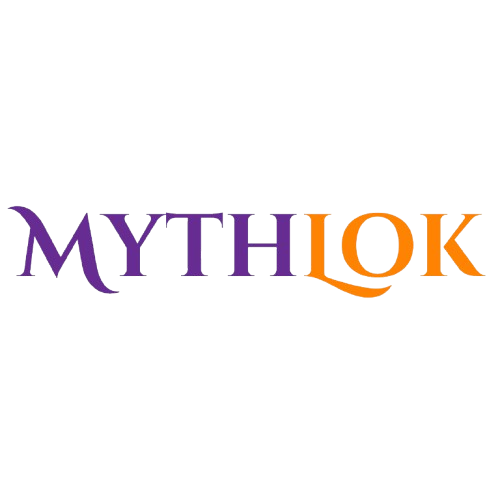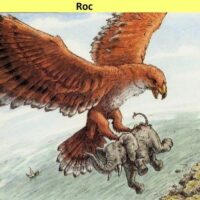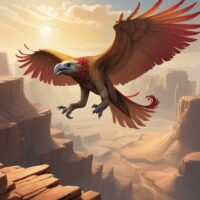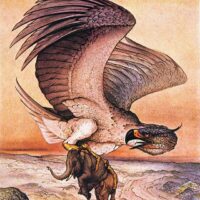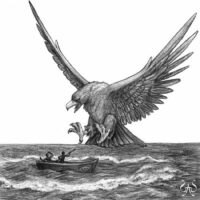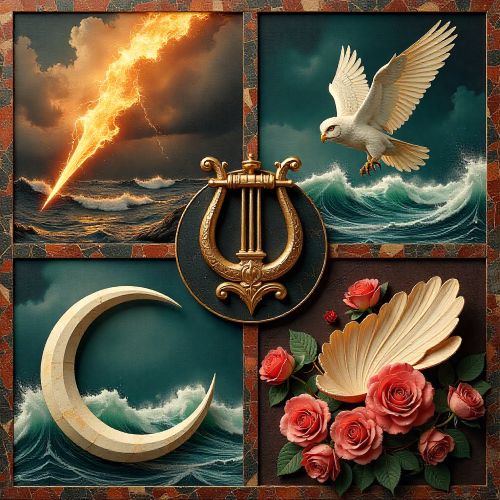Roc : The Giant Bird
Listen
At a glance
| Description | |
|---|---|
| Origin | Arabian Mythology |
| Classification | Animals |
| Family Members | N/A |
| Region | Middle East |
| Associated With | Size, Speed |
Roc
Introduction
In Arabian mythology, few creatures are as awe-inspiring as the Roc. This gargantuan bird of prey, known also as “Rukh,” “Rokh,” or “Ruc,” is a legendary being whose image is etched into the collective imagination of cultures worldwide. Its origins lie in ancient Arabian folklore, where it soared through centuries, leaving a mark on literature, art, and popular culture.
The Roc gained popularity through Arabian fairy tales and sailors’ folklore, most notably in “One Thousand and One Nights,” with stories like “Abd al-Rahman the Maghribi’s Story of the Rukh” and “Sinbad the Sailor.” Renowned for its colossal wingspan and incredible power, the Roc is often depicted as capable of carrying off elephants and other large animals in its talons. This mythical creature symbolizes the vast and untamed power of nature, embodying both awe and terror for those who encounter it in stories.
Rooted in the rich tapestry of Middle Eastern folklore, the Roc is frequently portrayed as a guardian of remote islands and uncharted territories. Its legends have been passed down through generations, evolving with each retelling. The Roc represents the intersection of the known world and the mysteries beyond, serving as a reminder of the vastness and unpredictability of nature.
Physical Traits
The Roc is an enormous bird, far larger than any known bird today, with a wingspan so vast it can block out the sun and cast shadows over the land below. Its feathers are depicted as being as large as palm leaves, while its talons are powerful enough to seize and carry off elephants and other large creatures effortlessly. The Roc’s beak is a formidable weapon, sharp and strong enough to tear apart its prey. In various accounts, its plumage ranges from pure white to vibrant shades of gold or red, adding to its mystique and otherworldly presence. As an apex predator, the Roc rules the skies, instilling fear in all who behold it with its immense size and strength.
Despite its monstrous proportions, the Roc is often depicted with a regal and majestic beauty, its plumage shimmering with iridescent hues. It is described as larger than an island, with wings that eclipse the sun and cast shadows stretching for miles. The Roc’s beak is said to cleave through mountains and ships with ease. Picture a colossal bird with wingspans that defy belief, capable of carrying off elephants and other large beasts for food, with quills measuring an astonishing twelve paces in length. As it soars above, it casts a shadow that darkens the land like a moving cloud, making this awe-inspiring creature both majestic and terrifying.
Family
While the Roc is often depicted as a solitary creature roaming the skies in search of prey, some tales suggest it has a family structure. The female Roc, sometimes referred to as a Rukh, is said to be even larger and more powerful than the male. Together, they are believed to lay enormous eggs, requiring entire forests for nesting. The young Roc, or Rochet, is described as rapidly growing, reaching adult size in just a few months. Some stories suggest the existence of multiple Rocs living in isolated regions or on remote islands, where they fiercely guard their nesting grounds and raise their young. While the Roc’s family structure is not extensively detailed, its solitary nature and dominance over its domain highlight its role as a powerful force in the natural world.
The Roc’s lineage is intertwined with other mythical beings. Its origins trace back to the fight between the Indian solar bird Garuda and the Chthonic serpent Nāga. In Sanskrit epics like the Mahabharata and the Ramayana, Garuda carries off an elephant battling a crocodile—a theme echoed in the Roc’s legend. Additionally, Sri Lankan mythology features the “Ath Kadha Lihini,” a bird that hunted elephants and cast shadows as vast as clouds. Wood carvings at the Embekka Temple depict this majestic creature. While the Roc’s existence is primarily a symbol of untamed power and majesty, its connections to these mythical creatures suggest a rich tapestry of cultural influences that have shaped its legend.
Other names
The Roc is known by a variety of names across different cultures, each reflecting its profound impact and characteristics. In Persian mythology, it is called the Simorgh, a symbol of great wisdom and power. In Turkish folklore, it is referred to as the Anka kuşu, a bird associated with rebirth and immortality. In Arabic, the Roc is known as the Rukh, a term that appears in literature and oral traditions throughout the Middle East. Western literature also mentions the Roc, sometimes using the name “Rukh” or “Roc Bird.”
These varied names highlight the Roc’s widespread influence and its deep roots in the cultural consciousness of many regions. Its names, including Rukh, Rokh, and Ruc, emphasize its cross-cultural significance and enduring legacy. The terms in Arabic and Persian, written as رخ (ruḵḵ in Arabic and ruḵ, rokh, or rukh in Persian), reflect its prominent role in global folklore.
Powers and Abilities
The Roc is renowned for its supernatural abilities beyond its sheer size and strength. It is attributed with remarkable speed and agility, capable of soaring to unimaginable heights. Some legends assert that the Roc can control the weather, conjuring storms and hurricanes at its will. Its intelligence is also notable, with the ability to understand human language and manipulate situations to its advantage.
The Roc’s immense strength allows it to capture and lift large prey, such as elephants, and drop them from great heights to shatter them. After dispatching its prey, the Roc is said to feast on it at its leisure. Marco Polo even reported that the Roc flew from southern regions to Madagascar, leaving behind a feather as proof. In addition to its physical prowess, the Roc’s keen eyesight enables it to spot prey from afar, making it an expert hunter. Its powerful wings allow it to travel vast distances and create storms, further enhancing its fearsome reputation.
Modern Day Influence
The Roc’s legend has persisted through the ages, remaining a captivating symbol in modern media. Its presence can be seen across various platforms, including literature, film, and video games, where it often represents untamed nature and the mysteries beyond human comprehension.
In literature, the Roc appears in Middle Eastern folklore adaptations, such as “One Thousand and One Nights,” where its immense size and strength drive adventurous narratives. In film, the Roc frequently features in adaptations of Sinbad the Sailor’s tales, acting as a formidable obstacle and guardian of uncharted territories, thus adding excitement to the storylines. Video games have embraced the Roc as a powerful entity, with players either confronting or aligning with this awe-inspiring creature, highlighting its majestic and formidable nature.
The Roc’s influence extends beyond entertainment, symbolizing concepts in contemporary discussions about nature and environmental preservation. Its depiction as a force of nature underscores the balance between humanity and the wilderness, prompting reflection on the impact of human actions on the environment. Artists and writers continue to draw inspiration from the Roc, using its image to symbolize ambition, power, and freedom. This enduring legacy reflects the bird’s continued significance in our collective imagination, embodying the power of myth and the mysteries of the natural world.
Related Images
Frequently Asked Questions
What is lorem Ipsum?
I am text block. Click edit button to change this text. Lorem ipsum dolor sit amet, consectetur adipiscing elit. Ut elit tellus, luctus nec ullamcorper mattis, pulvinar dapibus leo.
What is lorem Ipsum?
I am text block. Click edit button to change this text. Lorem ipsum dolor sit amet, consectetur adipiscing elit. Ut elit tellus, luctus nec ullamcorper mattis, pulvinar dapibus leo.
What is lorem Ipsum?
I am text block. Click edit button to change this text. Lorem ipsum dolor sit amet, consectetur adipiscing elit. Ut elit tellus, luctus nec ullamcorper mattis, pulvinar dapibus leo.
What is lorem Ipsum?
I am text block. Click edit button to change this text. Lorem ipsum dolor sit amet, consectetur adipiscing elit. Ut elit tellus, luctus nec ullamcorper mattis, pulvinar dapibus leo.
What is lorem Ipsum?
I am text block. Click edit button to change this text. Lorem ipsum dolor sit amet, consectetur adipiscing elit. Ut elit tellus, luctus nec ullamcorper mattis, pulvinar dapibus leo.

